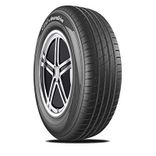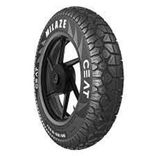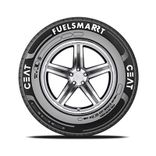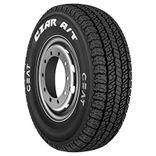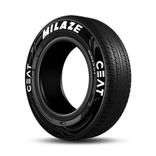Ad
Ad
How Tyre Pressure Can Make or Break Your Fuel Efficiency and Safety – Here's What You Need to Know!
Tyre pressure is crucial for optimal vehicle performance, safety, and fuel efficiency. Regularly checking tyre pressure helps you improve fuel economy, and avoid costly repairs. This guide explains how to measure, adjust, and maintain tyre pressure.
Ad
Ad

Tyres serve as the main point of contact between the road and the vehicle. Maintaining them plays a significant role in the optimal performance of the vehicle itself. And to maintain them efficiently, you need to keep a regular check on your tyre pressures. The correct air pressure enhances vehicle control, fuel efficiency and safety. As a result, you can lower fuel costs, gain better control over the handling and braking, as well as keep yourself and others on the road safe. However, it is one of the most critical factors of a vehicle that owners and drivers overlook.
In this article, we will shed light on tyre pressure and its impact on fuel efficiency and safety. Additionally, we also provide you with insights into maintaining proper tyre pressure so that you can get the most out of your tyres, and most importantly, ensure the safety of both the driver and passengers.
What is Tyre Pressure and How to Maintain it?
Tyre pressure is the amount of air filled inside a tyre. This amount of air inflates or deflates the tyre which can impact the overall performance and safety of your vehicle.
How tyre pressure is measured?
Tyre pressure is usually measured in pounds per square inch (PSI). The ideal PSI measurements of your vehicle can be found in the vehicle and the vehicle's manual. For bikes, you can find a Tyre Pressure Sticker on the rear swing arm or somewhere depending on the model. For cars, it is typically found on the driver-side door, depending on the model. Mostly, the average range of tyre pressure is 30-35 PSI.
How to check tyre pressure?
You can use a tyre pressure gauge to measure the air pressure on your tyres. Today, a lot of vehicles come with an inbuilt tyre pressure sensor that sends real-time tyre pressure readings on your dashboard console. Additionally, in India, every petrol pump has an air pump sub-station where you can check and adjust your tyre pressure free of cost.
When to check the tyre pressure?
It is recommended that the tyre pressure should be checked at least once every two weeks and every time before a long trip. It is best to check the pressure when the tyres are cold, it is because the rising temperature due to driving can increase the tyre pressure.
How to maintain the correct tyre pressure?
When cars are cold, the recommended tyre pressure is between 32 and 35 PSI. Cold here indicates that the tyres have not rolled or that the vehicle has been parked for 2-3 hours. Tyre pressure is sensitive to heat, and the heat generated by the friction of the tyres rolling on the road causes the tyre pressure to rise proportionally. The cold tyre pressure indicates the proper pressure at which the tyres should be when cold to perform optimally when hot. The best approach to finding out the correct tyre pressure for your vehicle is to look in the handbook or on the driver's side door.
How does tyre pressure impact fuel efficiency and safety?
Tyre pressure has long-term and short-term impacts on how your vehicle performs on the road. If the pressure is underinflated or overinflated, it can result in increased fuel consumption, decreased tyre lifespan, and in some cases loss of control over the vehicle.

Impact of Underinflated/Overinflated Tyres
Under-inflated tyres are one of the primary reasons for tyre failure. Under-inflated tyres allow too much of the tyre to contact the road, which not only increases friction but also demands more power supply from the engine to maintain the same speed. A tyre does not need to seem flat to be underinflated, so always ensure the appropriate pressure using a tyre gauge or inbuilt pressure sensor (if available). Moreover, it is a fact that a tyre that has 25% of its air removed, also seems to be completely inflated. Here are some of the effects of underinflated tyres.
- Higher rolling resistance causes the engine to work harder
- Reduced braking performance
- Reduced fuel efficiency
- Lack of control over bends under high speeds
- Wear and tear of tyre material
Overinflated tyres, on the other hand, result in a rougher ride, disrupt control and make uneven tread wear. There is an urban myth that the higher your tyre inflation, the better your fuel economy. This is not true. So, you have to always maintain the tyre inflation according to the recommended levels. Here are some of the effects of overinflated tyres.
- Increases the risk of tyre blowouts due to overheating from the friction
- Low tyre pressure leads to uneven wear and damaged tyre sidewalls
- Longer braking distances due to reduced traction
- Rough and bumpy ride due to less shock absorption
- Less responsive and difficult vehicle control

Impact of Inappropriate Tyre Pressure on Fuel Efficiency
Underinflated tyres increase your vehicle's drag, which boosts fuel consumption. But you may be wondering - By how much, exactly? Don’t worry we will make this clear today. A research conducted by the National Highway Traffic Safety Administration (NHTSA) in the United States discovered that every 1% deduction in tyre pressure corresponded to a 0.3% reduction in fuel economy. To bring it into perspective, the underinflation of tyres by 10% increases fuel consumption by 2%. Similarly, if the tyre is deflated by 40%, your vehicle will consume 8% more fuel for the same distance.
This can have a substantial impact over the long term, as tyres normally lose one to two PSI of pressure per month. Temperature variations can also influence tyre pressure. Every 5-degree centigrade reduction in temperature results in a 2% loss in tyre pressure. On the other hand, if the temperature rises by 5 degrees centigrade, the tyre additionally inflates by 2%. The temperature varies throughout the year in most of the corners of the planet, or even from day to night, that is the reason why the impact can be severe.
Impact of Tire Pressure on Safety
Tyre pressure has critical effects on driver and passenger safety. Underinflated or overinflated tyres can cause significant safety issues that can lead to unwanted accidents such as vehicle rollovers. These types of events can have fatal consequences for you and others on the road. That is why it becomes very important to check the tyre pressure on every ride. Automobile manufacturers are familiar with such issues, which is the reason they equip their vehicles with tyre pressure sensors as an additional safety feature.
Significance of Tire Pressure for Safety
Tyre pressure can impact safety in many ways:
Vehicle Handling and Control
Improper tyre pressure hinders vehicular control and makes it feel sluggish and unresponsive. If you do not have equipped the tyres with proper air pressure, you cannot judge the manoeuvre, especially on sharp turns. If you lose control, you may encounter fatal consequences.
Longer Braking Distance
Overinflated and underinflated tyres can cause the brakes to take a longer distance to stop the vehicle due to reduced traction. This condition is dangerous in emergencies where quick reaction is necessary.
Risks of Blowouts
Underinflated tyres often overheat due to the amount of friction, which can cause the tyre to blow out. This condition can be catastrophic which may lead to rollouts or collisions with other vehicles on the road.
CarBike360 Says
In essence, proper tyre pressure not only enhances fuel efficiency but is also vital to driver safety. You should regularly keep a close check on your tyre pressure to prevent accidents and fatal casualties due to loss of control, unresponsive braking, and blowouts. This is a simple yet effective maintenance task that not only helps you save money and increase the lifespan of your vehicle but also ensures the safety of you and others on the road.
Also Read: What’s the Difference between Electric and ICE Vehicles Tyres?
More Articles

Best Low Maintenance SUV Cars Under 20 Lakh in India 2025
Looking for an SUV that's budget-friendly and easy to maintain? Discover the best low-maintenance SUVs under ₹20 lakh in India for 2025, including top models with great mileage, reliability, and affordable service costs.
06-May-2025 11:02 AM
Read Full Article
Best Low Maintenance SUV Cars Under 20 Lakh in India 2025
Looking for an SUV that's budget-friendly and easy to maintain? Discover the best low-maintenance SUVs under ₹20 lakh in India for 2025, including top models with great mileage, reliability, and affordable service costs.
06-May-2025 11:02 AM
Read Full Article
Best Cruiser Bikes Under 10 Lakh Rupees in India 2025: Top Picks for Style and Comfort
Explore the best cruiser bikes under ₹10 lakh in India for 2025. Discover top models that offer a perfect blend of style, performance, and long-distance comfort.
06-May-2025 06:32 AM
Read Full Article
Best Cruiser Bikes Under 10 Lakh Rupees in India 2025: Top Picks for Style and Comfort
Explore the best cruiser bikes under ₹10 lakh in India for 2025. Discover top models that offer a perfect blend of style, performance, and long-distance comfort.
06-May-2025 06:32 AM
Read Full Article
Complete Guide to Lubricants for Passenger Vehicles: Cars, Bikes & Scooters
Discover the best lubricants for cars, bikes, and scooters. Improve performance, mileage, and engine life with expert tips.
30-Apr-2025 07:18 AM
Read Full Article
Complete Guide to Lubricants for Passenger Vehicles: Cars, Bikes & Scooters
Discover the best lubricants for cars, bikes, and scooters. Improve performance, mileage, and engine life with expert tips.
30-Apr-2025 07:18 AM
Read Full Article
Top 10 Premium Electric Cars in India & The Best Luxury EVs to Buy
Explore the top 10 premium electric cars in India, offering luxury, performance, and cutting-edge technology. Find the best EVs from brands like Audi, BMW, Mercedes, Porsche, and more.
03-Apr-2025 07:39 AM
Read Full Article
Top 10 Premium Electric Cars in India & The Best Luxury EVs to Buy
Explore the top 10 premium electric cars in India, offering luxury, performance, and cutting-edge technology. Find the best EVs from brands like Audi, BMW, Mercedes, Porsche, and more.
03-Apr-2025 07:39 AM
Read Full Article
Royal Enfield’s Classic Legacy & A Journey Through Time and Innovation
Discover the rich legacy of Royal Enfield’s Classic series, from the first-generation models to the latest ones. Explore its timeless design, powerful performance, and evolution through the years.
01-Apr-2025 08:48 AM
Read Full Article
Royal Enfield’s Classic Legacy & A Journey Through Time and Innovation
Discover the rich legacy of Royal Enfield’s Classic series, from the first-generation models to the latest ones. Explore its timeless design, powerful performance, and evolution through the years.
01-Apr-2025 08:48 AM
Read Full Article
The Xtreme 250R & Xpulse 210: A New Benchmark in Performance and Versatility
Hero MotoCorp elevates its game with the Xtreme 250R and Xpulse 210, two motorcycles designed to set new benchmarks in performance and versatility.
26-Mar-2025 02:12 PM
Read Full Article
The Xtreme 250R & Xpulse 210: A New Benchmark in Performance and Versatility
Hero MotoCorp elevates its game with the Xtreme 250R and Xpulse 210, two motorcycles designed to set new benchmarks in performance and versatility.
26-Mar-2025 02:12 PM
Read Full ArticleAd
Ad






